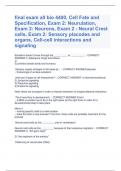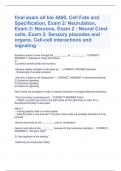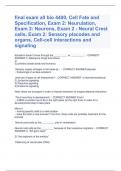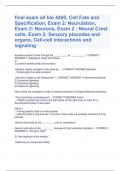Bio 4400 - Study guides, Class notes & Summaries
Looking for the best study guides, study notes and summaries about Bio 4400? On this page you'll find 14 study documents about Bio 4400.
Page 2 out of 14 results
Sort by

-
final exam all bio 4400, Cell Fate and Specification, Exam 2: Neurulation, Exam 2: Neurons, Exam 2 - Neural Crest cells, Exam 2: Sensory placodes and organs, Cell-cell interactions and signaling
- Exam (elaborations) • 95 pages • 2024
-
- $14.99
- + learn more
final exam all bio 4400, Cell Fate and Specification, Exam 2: Neurulation, Exam 2: Neurons, Exam 2 - Neural Crest cells, Exam 2: Sensory placodes and organs, Cell-cell interactions and signaling Ectoderm doesn't move through the __________ or __________ - CORRECT ANSWER 1) blastopore (frogs and fishes) or 2) primitive streak (birds and humans) Sensory organs all begin in the head as... - CORRECT ANSWER placode - thickenings of surface ectoderm what are 4 types of cell interact...

-
final exam all bio 4400, Cell Fate and Specification, Exam 2: Neurulation, Exam 2: Neurons, Exam 2 - Neural Crest cells, Exam 2: Sensory placodes and organs, Cell-cell interactions and signaling
- Exam (elaborations) • 95 pages • 2024
-
- $13.99
- + learn more
Ectoderm doesn't move through the __________ or __________ - CORRECT ANSWER 1) blastopore (frogs and fishes) or 2) primitive streak (birds and humans) Sensory organs all begin in the head as... - CORRECT ANSWER placode - thickenings of surface ectoderm what are 4 types of cell interactions? - CORRECT ANSWER 1) Internal/mechanical 2) Juxtacrine signaling 3) Paracrine signaling 4) Endocrine signaling Note: these are arranged in order of closest interaction to longest distance interact...

-
final exam all bio 4400, Cell Fate and Specification, Exam 2: Neurulation, Exam 2: Neurons, Exam 2 - Neural Crest cells, Exam 2: Sensory placodes and organs, Cell-cell interactions and signaling
- Exam (elaborations) • 95 pages • 2024
-
- $13.99
- + learn more
Ectoderm doesn't move through the __________ or __________ - CORRECT ANSWER 1) blastopore (frogs and fishes) or 2) primitive streak (birds and humans) Sensory organs all begin in the head as... - CORRECT ANSWER placode - thickenings of surface ectoderm what are 4 types of cell interactions? - CORRECT ANSWER 1) Internal/mechanical 2) Juxtacrine signaling 3) Paracrine signaling 4) Endocrine signaling Note: these are arranged in order of closest interaction to longest distance interact...

-
final exam all bio 4400, Cell Fate and Specification, Exam 2: Neurulation, Exam 2: Neurons, Exam 2 - Neural Crest cells, Exam 2: Sensory placodes and organs, Cell-cell interactions and signaling
- Exam (elaborations) • 95 pages • 2024
-
- $14.99
- + learn more
Ectoderm doesn't move through the __________ or __________ - CORRECT ANSWER 1) blastopore (frogs and fishes) or 2) primitive streak (birds and humans) Sensory organs all begin in the head as... - CORRECT ANSWER placode - thickenings of surface ectoderm what are 4 types of cell interactions? - CORRECT ANSWER 1) Internal/mechanical 2) Juxtacrine signaling 3) Paracrine signaling 4) Endocrine signaling Note: these are arranged in order of closest interaction to longest distance interact...

How much did you already spend on Stuvia? Imagine there are plenty more of you out there paying for study notes, but this time YOU are the seller. Ka-ching! Discover all about earning on Stuvia


